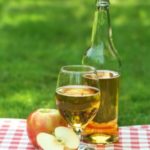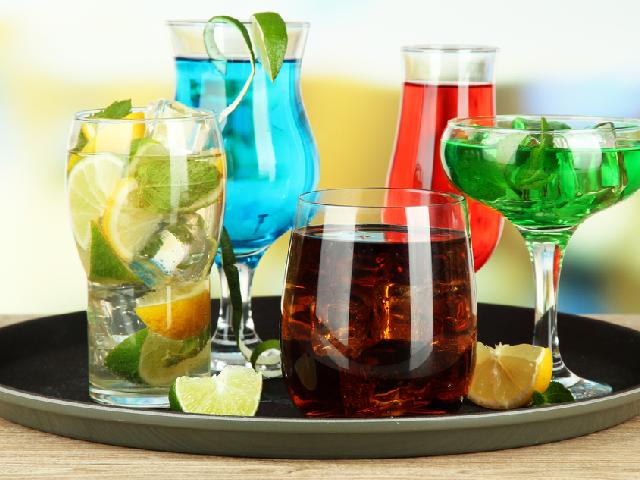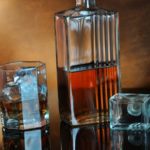Gin – bezbarwna wódka, o bardzo charakterystycznym smaku i aromacie. Może być otrzymywana na dwa sposoby: w wyniku redestylacji alkoholu z dodatkiem ziół, przypraw, korzeni, skórek

owoców (giny wyższej jakości), lub w wyniku samej ekstrakcji tychże ziół w wódce. Pełny skład komponentów ginu nie jest znany, jest tajemnicą konkretnych destylarni. Jednak głównym składnikiem, mającym największy wpływ na smak i aromat są owoce jałowca rodzaju Juniperus, które są komercyjnie uprawiane we Włoszech, Chorwacji, USA i Kanadzie. Pozostałe znane komponenty to: anyż, arcydzięgiel, cynamon, skórka pomarańczowa, kolendra i wiele innych ziół, przypraw i kor.
Historia ginu sięga 1600 roku, w którym to doktor Franciscus de la Boe na uniwersytecie w Laiden, stworzył lek na bazie alkoholu, ziół i owoców jałowca. Lek na dolegliwości żołądkowe, bardzo szybko zdobył popularność i był pity jako alkohol.
Największą popularność zdobył w Anglii, przywieziony z Holandii wraz z rewolucją która osadziła Wilhelma Orańskiego na tronie. Anglicy początkowo bardzo chętnie importowali gin z Holandii gdyż nie było na niego akcyzy jak na inne alkohole mocne. Zwiększona popularności i masowe spożycie ginu w Anglii spowodowało, że w 1734 roku rząd ogłosił zakaz przywozu i picia
ginu. Ustawa ta zapoczątkowała falę nielegalnej produkcji alkoholu w Anglii. Szacuje się, że co 4 rodzina w tym czasie destylowała, produkowała nielegalnie alkohol w domu. W tych czasach gin kojarzony był z alkoholem dla biedoty.
Zniesienie prohibicji w Anglii i nadejście ery wiktoriańskiej, zapoczątkowało powolną poprawę jakości wytwarzanego Ginu. W połowie XIX wieku powstają już pierwsze receptury nowego trunku i powstają znane nazwy jak: Dry Gin i London Gin.
Gin szybko stał się alkoholem brytyjskiej armii, popijany na wszystkich frontach i we wszystkich koloniach. Najbardziej znany drink Gin & Tonic powstał w Indiach, gdzie brytyjscy żołnierze mieszali Gin z codzienną dawką chininy (która miała chronić przed malarią) i wodą gazowaną (chinina rozpuszczona w wodzie gazowanej tworzy tonic).
Obecnie Gin jest jednym z najpopularniejszych alkoholi, pity jako aperitif lub jako dodatek wielu drinków.
Najbardziej znane drinki to:

Gin & Tonic: 50ml Ginu wlewamy do szklanki z lodem, dodajemy kilka plasterków cytryny lub limonki i dopełniamy tonikiem.
Orange Gin: 40ml Ginu, 100ml soku pomarańczowego – składniki energicznie wymieszać w shakerze, przelać do wysokiej szklanki z lodem, udekorować plasterkiem pomarańczy.
Paradiso: 30ml Ginu, 20ml Apricot Brandy, 100ml soku pomarańczowego – składniki wymieszać w shakerze i przelać do wysokiej szklanki, udekorować plasterkiem pomarańczy.
Aperitif Martini Dry: 50ml Ginu, 10ml wytrawnego wermutu – składniki energicznie mieszamy w szklanicy barmańskiej z lodem i przelewamy do kieliszka koktajlowego.
Aperitif Bronx: 40ml Ginu, 20ml czerwonego wermutu, 30ml soku pomarańczowego – składniki energicznie wymieszać w shakerze z lodem i przelać do kieliszka koktajlowego.
Aperitif Campari&Gin: 20ml Campari, (esencja Campari), 20ml Ginu, 20ml czerwonego wermutu – wszystkie składniki mieszamy w shakerze z lodem, przelewamy do kieliszka koktajlowego, dekorujemy plasterkiem pomarańczy.
Aperitif Inca: 20ml Ginu, 20ml sherry, 20ml wytrawnego wermutu, 20ml czerwonego wermutu – składniki energicznie wymieszać w szklanicy z lodem, przelać do kieliszka koktajlowego, udekorować skórką cytryny.
Blue Gin Bubbles: 20ml Ginu, 20ml Curacao Blue (dostępne w formie esencji), 20ml soku cytrynowego, wino musujące do uzupełnienia – Gin, CuracaoBlue i sok cytrynowy mieszamy w shakerze, przelewamy do kieliszka i uzupełniamy winem musującym.

Znaleziono w Google poprzez frazy:
- swojska nazwa ginu
- gin domowy
- jak zrobić gin
- swojska nazwa dżinu
- gin bardziej swojsko







